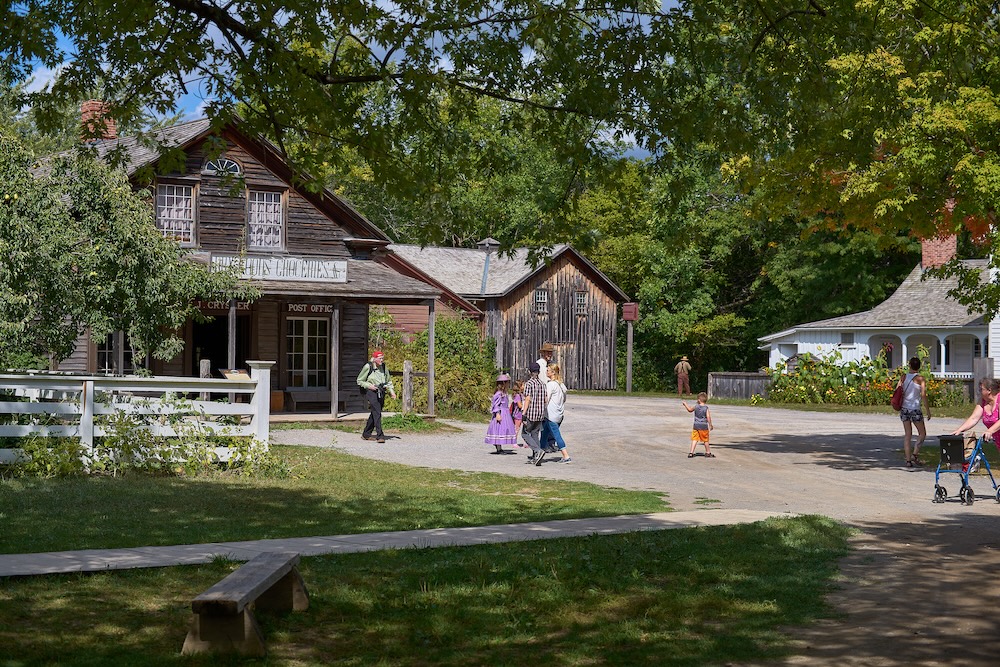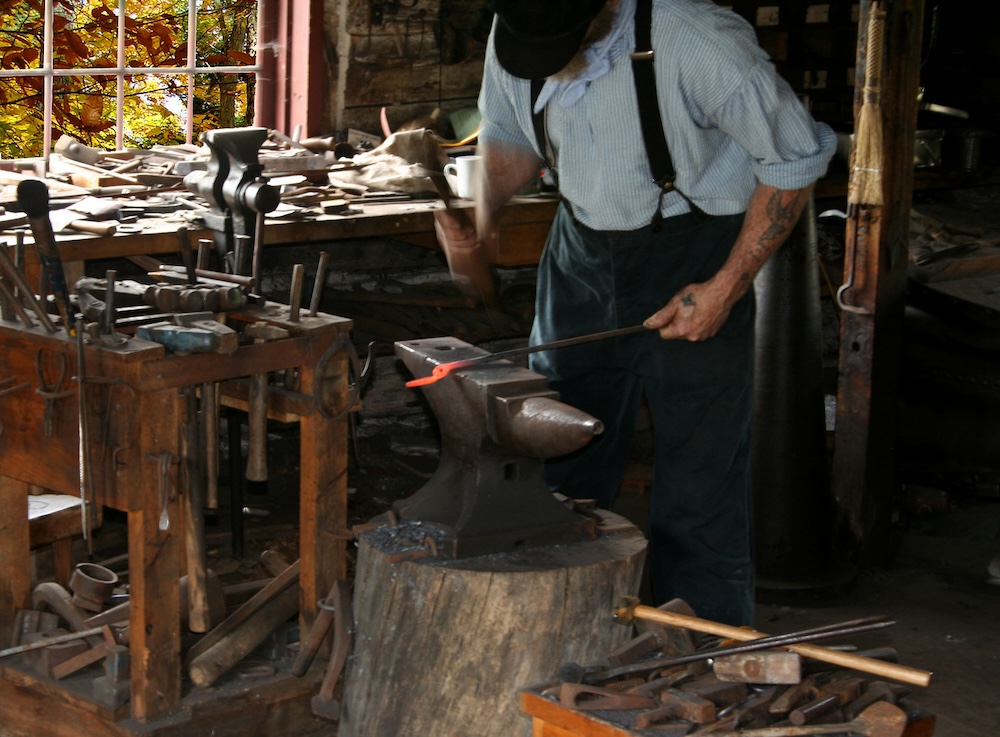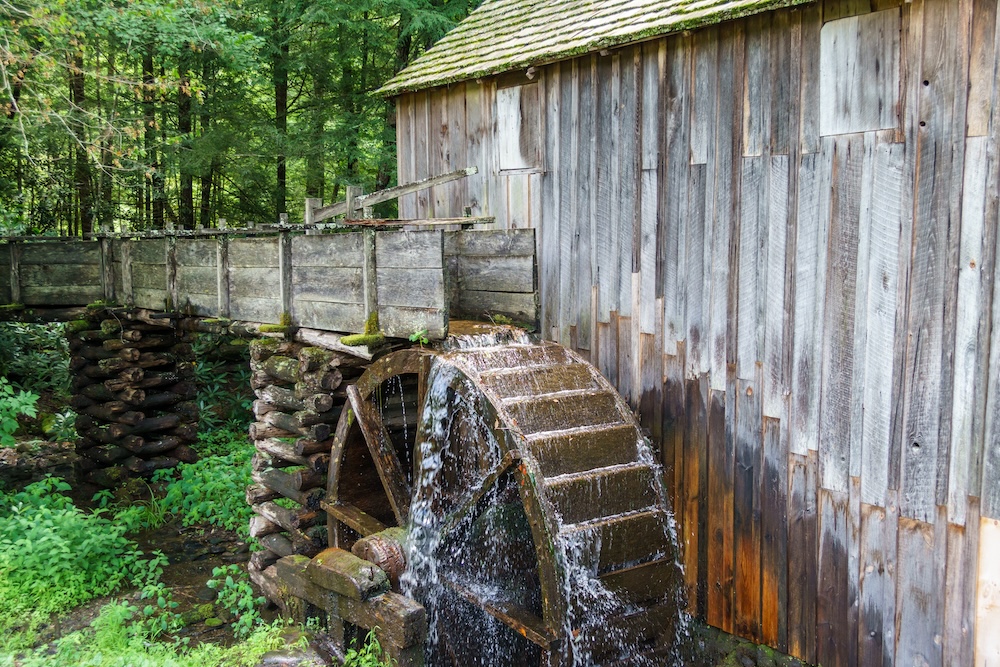Living museums provide the opportunity to step back into the past, offering experiences that bring history to life in a way no book, movie, or classroom ever could. At Upper Canada Village, where it is 1866 every day, it’s feeling the heat emanate from the forge as the blacksmith’s hammer shapes red-hot iron into useful tools, or the splashing and floor-shaking of water-powered turbines, or smelling the warm bread from the wood-fired brick oven that makes history a real-life sensory adventure.
But lessons of the past are not all these historic sites have to offer. While it may seem counter-intuitive, full immersion in the past is also an occasion to consider the future. Oftentimes, we think that the value of history is that we don’t repeat our mistakes, but there is an argument to be made that there is value in some facets of the past that ought to be repeated. In particular, many aspects of 19th-century life offer lessons in sustainability that could be useful as we seek to reduce our impact on the planet and teach younger generations how to be resource-conscious in their decision-making.
 An example of a living history museum is Upper Canada Village in Ontario. This working village showcases functional trades typical of rural life in the region in the 1860s. Then, rural life centred around agriculture, and the farms at Upper Canada Village work the land with horses and oxen, much as it was done 150 years ago when all farming was sustainable.
An example of a living history museum is Upper Canada Village in Ontario. This working village showcases functional trades typical of rural life in the region in the 1860s. Then, rural life centred around agriculture, and the farms at Upper Canada Village work the land with horses and oxen, much as it was done 150 years ago when all farming was sustainable.
Unlike the fuel used to power large tractors and modern combine harvesters, horses and oxen ate hay and other produce grown by the farm they lived on. In turn, the manure they produced enriched the soil on the farm, producing more crops.
In a similar manner, farms would supply local cheese factories with milk and put the by-product to good use. When making cheddar cheese, most fats and proteins from the milk solidify and are pressed together to form the cheese. At the end of the process, a protein-rich liquid known as whey is left over. In the 19th century, this whey was returned to the farmers who supplied the milk. They would feed it to their pigs, who converted it to muscle and fat, like modern bodybuilders who consume whey powder in protein drinks. What would have been thrown away now becomes an important food source for farm families.
We could all benefit from learning or remembering the lessons that what looks like waste can be useful and that processes can be self-sustaining. With ever-decreasing resources, finding and/or resuming sustainable farming practices in the modern world is essential for ensuring that the land will continue to grow food for future generations.
If returning to a time of literal horse power seems too inconvenient by today’s standards, Upper Canada Village also showcases more “modern” earth-friendly innovations.
Hydroelectric projects are currently being promoted as a renewable way of generating clean energy, but the technology isn’t as new as some might think. Water-powered mills were a regular part of life for people in the 1860s. Upper Canada Village has three different mills, each using the rush of water through turbines to generate the power needed to saw lumber, weave blankets, or grind wheat into flour.
By the 19th century, water power had been harnessed for these uses for thousands of years, but the Industrial Revolution had led to improvements in turbine design and mill construction that allowed for greater force to be produced more efficiently using less water. Gravity is the prime mover in bringing water down to and through the turbine, so energy costs were free as long as water continued to flow.
Unlike today, where water is used to generate electricity, which in turn is used to power hundreds of different applications, the water turbines of the 19th century either connected directly to the machinery they powered or stored their power in large fly-wheels—heavy, geared weights which, once set in motion, allowed energy to be stored and redistributed over short periods of time, much like a battery does today but without the need to dispose of
dangerous chemicals.

Inside the blacksmith’s shop are demonstrations of early recycling. In rural communities, the blacksmith played an indispensable role, fixing and supplying a wide variety of metal items including tools, hardware, and machinery. The properties of forged metal being what they are, rather than replacing broken parts with new ones, the blacksmith could reheat, reshape, and repair, using original pieces.
It’s all too easy to think of metal being an unchangeable solid that is difficult to work, but a 19th-century blacksmith knew that in experienced hands, metal could have new life. An old, worn-out file could become a new sharp knife, or a broken axe could become a new garden hoe. Old unused metal wasn’t wasted but was forged into new, useful items.
The properties of metal have not changed, so the principle remains true to today. In the right hands, empty cans and other metals can (and should) be melted down and recycled into something new.
 Recycling, clean energy, and waste recovery were all part of daily life in the 1860s, though few people thought of these things in the same terms that we do today. For them, sustainable practices were just smart ways of reducing costs, improving production, and reducing the need to bring in difficult-to-obtain resources or supplies.
Recycling, clean energy, and waste recovery were all part of daily life in the 1860s, though few people thought of these things in the same terms that we do today. For them, sustainable practices were just smart ways of reducing costs, improving production, and reducing the need to bring in difficult-to-obtain resources or supplies.
Everything old can be new again. And that’s what living history museums have to offer to classrooms of students today who will be tomorrow’s problem-solvers and earth stewards—a modern look at historic solutions to everyday problems not unlike the challenges we face today. That lessons of the past can be made new again, into something useful for the future.
Living Museums in Canada
Ault Park (South Stormont, ON)
Backus-Page House Museum (Wallacetown, ON)
Batoche (Saskatchewan)
Barkerville, (Barkerville, BC)
Black Creek Pioneer Village (Toronto, ON)
Fanshawe Pioneer Village (London, ON)
Fort Edmonton Park (Edmonton, AB)
Fort George (Niagara-on-the-Lake, ON)
Fort Gibraltar (St. Boniface, MB)
Fort Henry National Historic Site (Kingston, ON)
Fort Malden National Historic Site (Amherstburg, ON)
Fort Normandeau (Red Deer, AB)
Fort St. James National Historic Site (Fort St. James, BC) Fort Wellington National Historic Site (Prescott, ON)
Fort William Historical Park (Thunder Bay, ON)
Fortress of Louisbourg National Historic Site (Louisburg, NS) Citadel Hill (Halifax, NS)
Heritage Park Historical Village (Calgary, AB)
Kings Landing (Prince William, NB)
‘Ksan (Hazelton, BC)
Lang Pioneer Village Museum (Lang, ON)
Lower Fort Garry (Winnipeg, MB)
Norstead Viking Village (L’Anse aux Meadows, NL) Sainte-Marie among the Hurons (Midland, ON)
Ukrainian Cultural Heritage Village (Lamont County, AB) Upper Canada Village (Morrisburg, ON)
Village Historique Acadien (Bertrand, NB)
ABOUT THE AUTHOR
Julian Whittam
Julian Whittam is the Coordinator of Interpretation for Upper Canada Village in Morrisburg, Ontario; one hour from Ottawa, two hours from Montreal and four hours from Toronto. The Village welcomes school groups between April and September each year with special education tour rates. julian.whittam@parks.on.ca
This article is featured in Canadian Teacher Magazine’s Winter 2024 issue.









